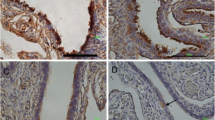Abstract
Purpose: To determine whether a confluent culture of fallopian ampullary epithelial cells, taken from women at the end of their reproductive life, is capable of rescuing very-poor-quality preembryos from cleavage arrest and/or degeneration.
Methods: Human preembryos, rejected for transfer or freezing because of very poor quality, and arrested within 24 h of cleavage, were cultured for 5 days in medium alone or over a confluent culture of fallopian ampullary epithelial cells. Morphological criteria were utilized to assess preembryo degeneration and stage of development.
Results: The described coculture rescued preembryos from degeneration, enhancing development to the blastocyst stage 2.2-fold, compared with cultures in medium alone. Furthermore, fully expanded and hatching blastocysts were observed only under coculture conditions.
Conclusions: Very-poor-quality human preembryos may be rescued from degeneration, and their growth and development dramatically improved, when cocultured with a confluent culture of fallopian ampullary epithelial cells.
Similar content being viewed by others
REFERENCES
Quinn P: Use of co-culture with cumulus cells in insemination medium in human in vitro fertilization (IVF). J Assist Reprod Genet 1994;11:270-277
Plachot M, Antoine JM, Alvarez S, Firmin C, Pfister A, Mandelbaum J, Junca AM, Salat-Baroux J: Granulosa cells improve human embryo development in vitro. Hum Reprod 1993;8:2133-2140
Dirnfeld M, Goldman S, Gonen Y, Koifman M, Calderon I, Abramovic H: A simplified co-culture system with luteinized granulosa cells improves embryo quality and implantation rates: A controlled study. Fertil Steril 1997;67:120-122
Bongso A, Soon-Chye N, Sathananthan H, Lian NP, Rauff M, Ratnam S: Improved quality of human embryos when cocultured with human ampullary cells. HumReprod 1989;4:706-713
Jayot S, Parneix I, Verdaguer S, Discamps G, Audebert A, Emperaire JC: Co-culture of embryos on homologous endometrial cells in patients with repeated failures of implantation. Fertil Steril 1995;63:109-114
Wiemer KE, Cohen J, Amborski GF, Wright G, Wiker S, Munyakazi L, Godke RA: In vitro development and implantation of human embryos following culture on fetal bovine uterine fibroblast cells. Hum Reprod 1989;4:595-600
Menezo YJ, Guerin JF, Czyba JC: Improvement of human early embryo development in vitro by co-culture on monolayers of Vero cells. Biol Reprod 1990;42:301-306
Schillaci R, Ciriminna R, Cefalu E: Vero cell effect on in vitro human blastocyst development: Preliminary results. Hum Reprod 1994;9:1131-1135
Hu Y, Maxson W, Hoffman D, Ory S, Eager S, Dupre J, Worrilow K: Co-culture with assisted hatching of human embryos using Buffalo rat liver cells. Hum Reprod 1998;13:165-168
Van Blerkom J: Development of human embryos to the hatched blastocyst stage in the presence or absence of a monolayer of Vero cells. Hum Reprod 1993;8:1525-1539
Lai YM, Wang HS, Lee CL, Lee JD, Huang HY, Chang FH, Lee JF, Soong YK: Insulin-like growth factor-binding proteins produced byVero cells, human oviductal cells and human endometrial cells, and the role of insulin-like growth factor-binding protein-3 in mouse embryo co-culture systems. Hum Reprod 1996;11:1281-1286
Yeung WS, Lau EY, Chan AY, Ho PC: The production of interleukin-1 alpha immunoreactivity by human oviductal cells in a co-culture system. J Assist Reprod Genet 1996;13:772-775
Fukaya T, Chida S, Murakami T, Yajima A: Is direct cell-to-cell contact needed to improve embryonic development in co-culture? Tohoku J Exp Med, 1996;180:225-232
Simón C, Gimeno MJ, Mercader A, O'Connor JE, Remohí J, Polan ML, Pellicer A: Embryonic regulation of integrins β3,α4, and α1 in human endometrial epithelial cells in vitro. J Clin Endocrinol Metab 1997;82:2607-2616
Bavister BD: Co-culture for embryo development: Is it really necessary? [editorial]. Hum Reprod 1992;7:1339-1341
Watson AJ, Watson PH, Warnes D, Walker SK, Armstrong DT, Seamark RF: Preimplantation development of in vitromatured and in vitro-fertilized ovine zygotes: Comparison between co-culture on oviduct epithelial cell monolayers and culture under low oxygen atmosphere. Biol Reprod 1994;50:715-724
Wiemer KE, Garrisi J, Steuerwald N, Alikani M, Reing AM, Ferrara TA, Noyes N, Cohen J: Beneficial aspects of co-culture with assisted hatching when applied to multiple-failure in vitro fertilization patients. Hum Reprod 1996;11:2429-2433
Menezo Y, Hazout A, Dumont M, Herbaut N, Nicollet B: Co-culture of embryos on Vero cells and transfer of blastocysts in humans. Hum Reprod 1992;7(Suppl 1):101-106
Bongso, A, Fong C-Y, Ng S-C, Ratnam S: Human embryonic behavior in a sequential human oviduct-endometrial co-culture system. Fertil Steril 1994;61:976-978
Janny L, Menezo YJR: Maternal age effect on early human embryonic development and blastocyst formation. Mol Reprod Dev 1996;45:31-37
Balaban B, Urman B, Sertac A, Alatas C, Aksoy S, Nuhoglu A: Progression of excess embryos to the blastocyst stage predicts pregnancy and implantation rates after intracytoplasmic sperm injection. Hum Reprod 1998;13:2564-2567
Olivennes F, Hazout A, Lelaidier C, Freitas S, Fanchin R, de Ziegler D, Frydman R: Four indications for embryo transfer at the blastocyst stage. Hum Reprod 1994;9:2367-2373
Shoukir Y, Chardonnens D, Campana A, Bischof P, Sakkas D: The rate of development and time of transfer play different roles in influencing the viability of human blastocysts. Hum Reprod 1998;13:676-681
Wun WS, Wun CC, Valdes CT, Dunn RC, Grunert GM: Blastocyst formation is a good indicator for attainment of assisted reproduction. Chin J Physiol 1997;40:237-242
Parikh FR, Kamat SA, Nadkarni S, Arawandekar D, Parikh RM: Assisted hatching in an in vitro fertilization programme. J Reprod Fertil Suppl 1996;50:121-125
Magli MC, Gianaroli L, Ferraretti AP, Fortini D, Aicardi G, Montanaro N: Rescue of implantation potential in embryos with poor prognosis by assisted zona hatching. Hum Reprod 1998;13:1331-1335
Le DR, Lee JE, Yoon HS, Lee HJ, Kim MK, Roh SI: The supplementation of culture medium with protease improves the hatching rate of mouse embryos. Hum Reprod 1997;12:2493-2498
Martin KL, Barlow DH, Sargent IL: Heparin-binding epidermal growth factor significantly improves human blastocyst development and hatching in serum-free medium. Hum Reprod 1998;13:1645-1652
Author information
Authors and Affiliations
Corresponding author
Rights and permissions
About this article
Cite this article
Weichselbaum, A., Paltieli, Y., Philosoph, R. et al. Improved Development of Very-Poor-Quality Human Preembryos by Coculture with Human Fallopian Ampullary Cells. J Assist Reprod Genet 19, 7–13 (2002). https://doi.org/10.1023/A:1014002404950
Issue Date:
DOI: https://doi.org/10.1023/A:1014002404950




